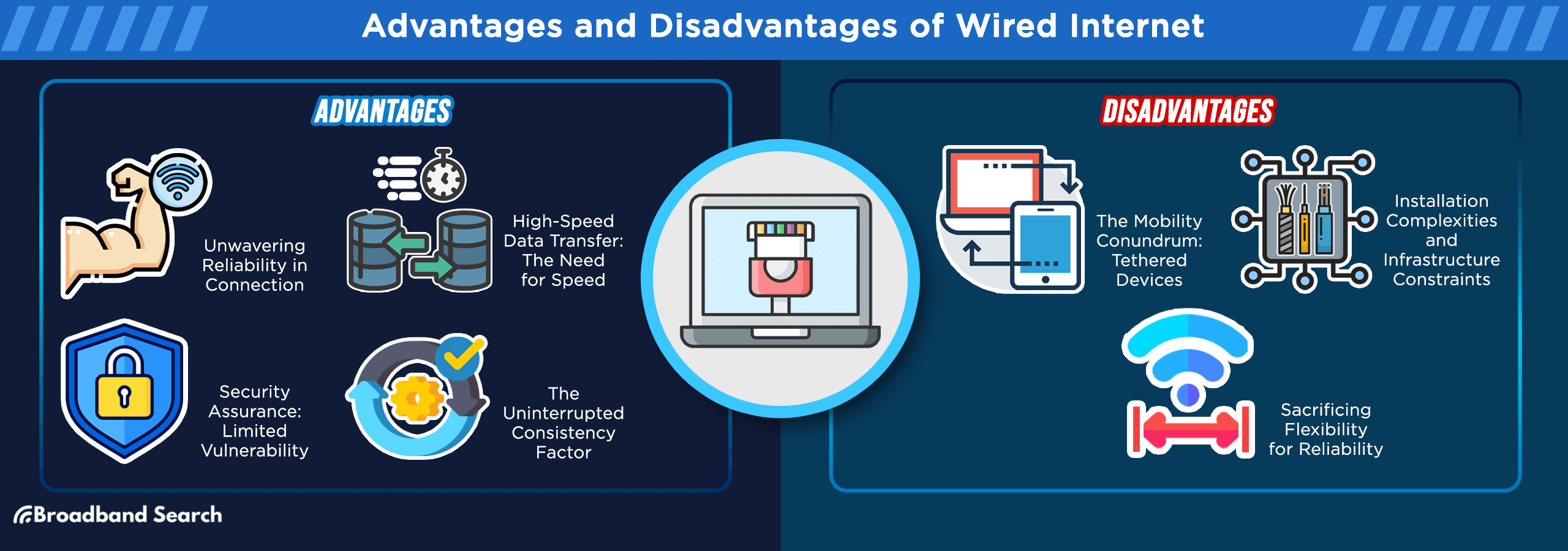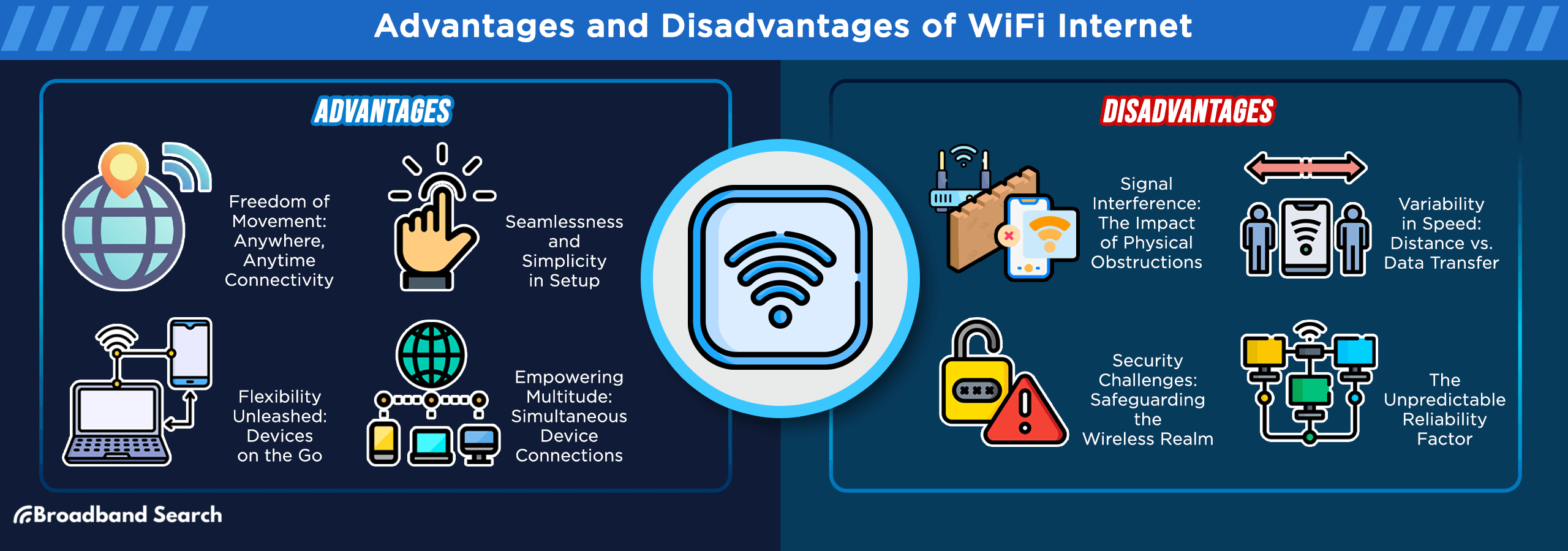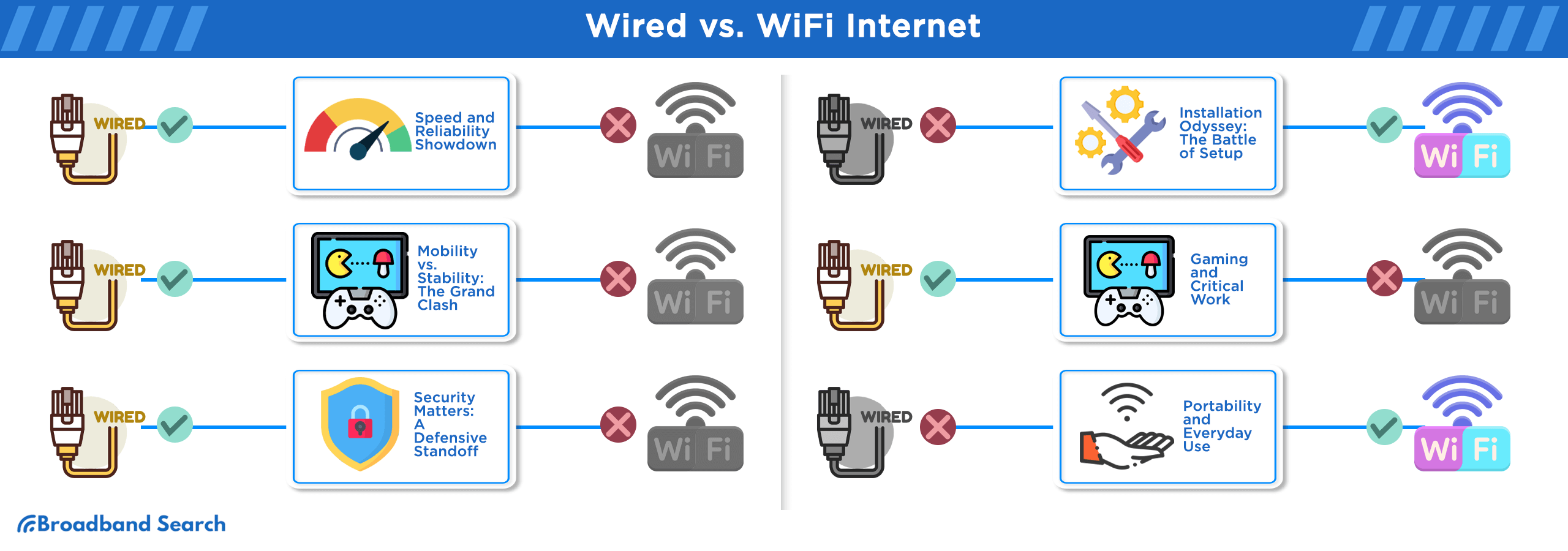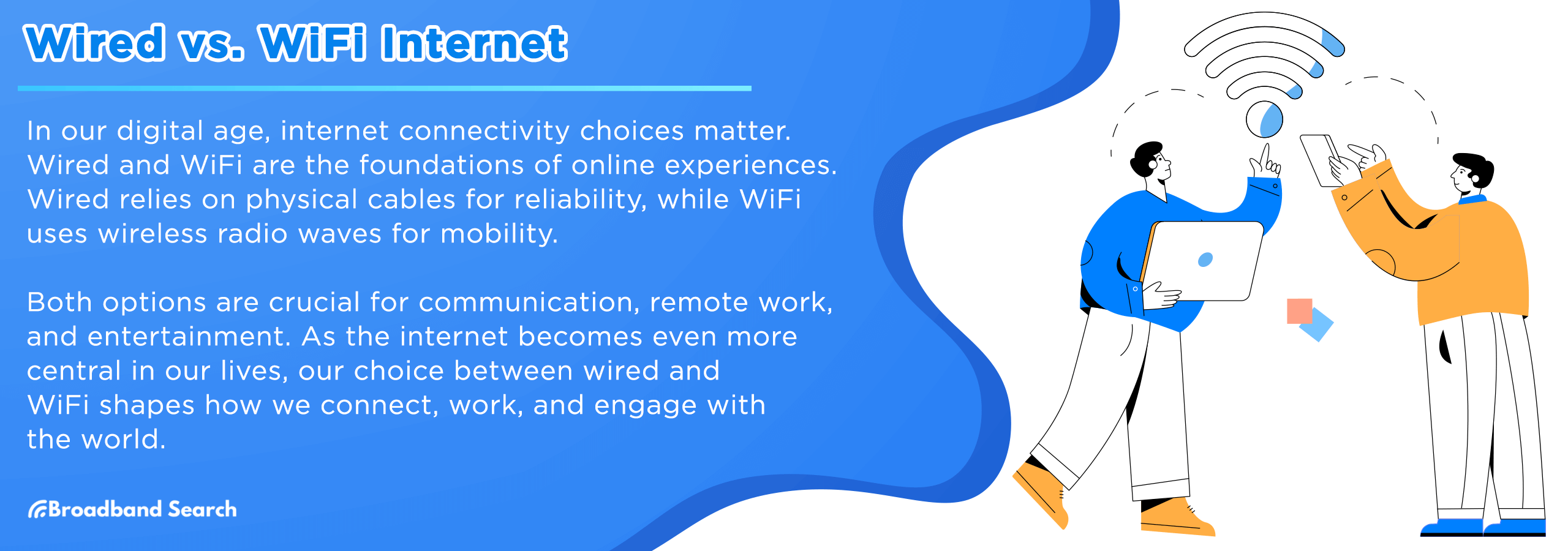In our digitally interconnected age, our choices regarding internet connectivity hold immense significance. Wired and WiFi technologies stand as the cornerstones of our online experiences. Wired internet relies on physical connections via Ethernet cables, offering reliability and stability. In contrast, WiFi harnesses wireless radio waves, providing mobility and convenience.
Both options play pivotal roles in modern society, enabling seamless communication, powering remote work, and enriching entertainment. As the internet plays an increasingly central role in our lives, our decision between wired and WiFi becomes more impactful, shaping how we work, connect, and engage with the world around us.
The Stable Backbone: Wired Internet
Decoding the Wired Connection
Infrastructure using Ethernet Cables
Wired internet relies on tangible connections established through Ethernet cables. These cables serve as the physical bridge that links devices directly to routers and modems, allowing data to flow seamlessly. These Ethernet cables transmit data using electrical signals, providing a reliable and consistent pathway for information exchange. It's worth noting that these cables come in different categories, such as Cat 5e, Cat 6, and Cat 6a, each offering distinct data transmission capabilities.
The Ethernet cables create a reliable conduit, minimizing the risk of signal loss and interference associated with wireless options. Additionally, these physical connections offer higher data transfer rates compared to their wireless counterparts, contributing to a more consistent online experience.
Emphasis on Consistency and Reliability
The wired internet's consistent signal strength and reliability stem from its physical nature. The direct link established by Ethernet cables eliminates the potential for signal degradation caused by distance or obstacles. This reliability is especially crucial for activities requiring a stable connection, such as video conferencing, online gaming, and large data transfers.

Advantages of Wired Internet
1. Unwavering Reliability in Connection
Wired connections are notably less susceptible to external interference compared to wireless connections. Factors like walls, other electronic devices, and radio frequency congestion have minimal impact on wired connections. This reliability is crucial for activities that require a steady and uninterrupted connection, such as online gaming and video conferencing, where even slight interruptions can disrupt the experience.
2. High-Speed Data Transfer: The Need for Speed
Wired connections generally offer higher data transfer rates compared to their wireless counterparts. For example, Gigabit Ethernet connections can support data transfer speeds of up to 1 gigabit per second (Gbps) or even higher. This makes wired connections ideal for tasks involving large file transfers, high-definition video streaming, and online backups.
3. Security Assurance: Limited Vulnerability
The confined nature of wired connections limits the potential for unauthorized access. Since the signal is confined to the physical cables, the risk of eavesdropping or hacking is significantly reduced. This can be particularly advantageous for sensitive activities like online banking or accessing confidential work documents.
4. The Uninterrupted Consistency Factor
Wired connections maintain consistent signal strength regardless of factors like distance or obstacles. This consistency contributes to a seamless online experience, as users don't have to worry about sudden drops in connection or slowdowns due to changing environmental conditions.
Drawbacks of Wired Internet
1. The Mobility Conundrum: Tethered Devices
One of the main drawbacks of wired connections is the lack of mobility. Devices must remain physically connected to the Ethernet cable, limiting their range and movement. This can be inconvenient, especially for portable devices like laptops and smartphones that are designed for mobility.
2. Installation Complexities and Infrastructure Constraints
Installing wired connections involves running Ethernet cables through walls, floors, or ceilings. This can be challenging, especially in existing structures where retrofitting cables might require drilling and modifications. Additionally, setting up wired connections may require professional assistance for complex installations.
3. Sacrificing Flexibility for Reliability
While wired connections offer superior reliability, this often comes at the expense of flexibility. Devices must be positioned within the reach of the Ethernet cable, limiting their placement options. This lack of flexibility can be a deterrent for users who prioritize mobility and convenience over consistent connectivity.
Liberation Through Waves: WiFi Internet
Navigating the World of WiFi
Harnessing Wireless Technology via Radio Waves
- WiFi operates by transmitting data using radio waves, which allow for wireless communication between devices and routers. These waves function within specific frequency bands, such as 2.4 GHz and 5 GHz. The wireless nature of WiFi eliminates the need for physical connections, providing a seamless and convenient way to connect devices.
Prioritizing Mobility and Ease of Use
- WiFi's wireless nature liberates devices from the constraints of physical cables. This mobility enables users to move freely within the signal range while maintaining connectivity. The setup process for WiFi networks is designed to be user-friendly, often involving password input and device selection. This simplicity has made WiFi an accessible choice even for those with limited technical knowledge.
Advantages of WiFi Internet

1. Freedom of Movement: Anywhere, Anytime Connectivity
WiFi allows devices to connect from various areas within the signal range. Users can enjoy internet access from different rooms, floors, or even outdoor spaces. This freedom of movement enhances convenience, enabling users to stay connected without being restricted to a specific location.
2. Seamlessness and Simplicity in Setup
WiFi connections are designed to be plug-and-play, minimizing the setup process's complexity. Users can simply connect to a WiFi network by selecting it and entering the appropriate password. This simplicity has contributed to the widespread adoption of WiFi in homes, cafes, airports, and other public places.
3. Flexibility Unleashed: Devices on the Go
WiFi's flexibility is particularly beneficial for mobile devices like laptops, tablets, and smartphones. These devices can easily switch between different WiFi networks, allowing users to stay connected while on the move. Additionally, portable hotspots, often using cellular data, provide internet access in areas without traditional WiFi coverage.
4. Empowering Multitude: Simultaneous Device Connections
Modern WiFi routers are equipped to handle multiple device connections simultaneously. This is especially valuable in households and offices where numerous devices require internet access. The ability to accommodate multiple devices without significant slowdowns is a key advantage of WiFi networks.
Drawbacks of WiFi Internet
1. Signal Interference: The Impact of Physical Obstructions
WiFi signals can be weakened by physical obstacles such as walls, floors, and large objects. This interference can lead to signal dead zones within a property. WiFi range extenders or mesh systems can help alleviate this issue by extending coverage to areas with weak signals.
2. Variability in Speed: Distance vs. Data Transfer
The distance between a device and the WiFi router affects the connection speed. The farther a device is from the router, the weaker the signal and potentially slower the speed. Additionally, data transfer rates can vary based on the number of devices connected and the type of data being transferred.
3. Security Challenges: Safeguarding the Wireless Realm
WiFi networks are vulnerable to unauthorized access if not properly secured. Weak passwords or outdated security protocols can lead to breaches. Strong encryption, such as WPA3, and unique, complex passwords are essential to prevent unauthorized users from accessing the network.
4. The Unpredictable Reliability Factor
WiFi connections can be influenced by environmental factors such as electronic interference, neighboring WiFi networks, and congestion on the same frequency bands. This can lead to inconsistent speeds and potential drops in connectivity, particularly in densely populated areas.
Head-to-Head: A Duel of Connectivity

Speed and Reliability Showdown
Wired's Ironclad Speed vs. WiFi's Speed Spectrum
When it comes to speed, wired connections are often unparalleled. Ethernet cables can support Gigabit speeds (1 Gbps or more), providing consistent and high-speed data transfer. In contrast, WiFi speeds can vary based on factors like signal strength, distance, and interference. While modern WiFi standards like 802.11ac (WiFi 5) and 802.11ax (WiFi 6) have significantly improved wireless speeds, they might not always match the consistency of wired connections.
For high-definition streaming, such as 4K video, wired connections shine due to their stable and high-speed nature. Consistent speeds ensure that streaming is smooth without buffering or quality drops, offering an optimal viewing experience.
Mobility vs. Stability: The Grand Clash
WiFi's Dynamic Mobility vs. Wired's Grounded Reliability
WiFi's mobility allows users to move freely within the signal range, making it ideal for mobile devices and users on the go. On the other hand, wired connections offer grounded reliability by eliminating the variables that can weaken wireless signals. This stability is beneficial for tasks that require a consistent and stable connection, such as online gaming or video conferencing.
In a scenario where a user is working from home, WiFi's mobility allows them to work from any room. However, for a professional gamer, the stability of wired connections is crucial to prevent lag during intense gameplay. These attributes can complement each other in hybrid setups, where users benefit from both stability and mobility.
Security Matters: A Defensive Standoff
Wired's Secure Fortitude vs. WiFi's Potential Breach
In terms of security, wired connections have a natural advantage due to their physical nature. The data transmitted through cables is difficult to intercept unless someone gains direct access to the cables. On the other hand, WiFi networks are susceptible to breaches, as cybercriminals can exploit vulnerabilities to intercept data or gain unauthorized access.
Instances of WiFi password cracking or unauthorized network access can expose sensitive data to malicious actors. Public WiFi networks, if not properly secured, can also become breeding grounds for attacks like man-in-the-middle attacks.
Wired connections, due to their limited physical access points, are inherently more secure. WiFi, being wireless, requires robust security measures such as encryption (WPA3) and strong passwords to mitigate potential breaches.
Installation Odyssey: The Battle of Setup
Wired's Complex Journey vs. WiFi's Plug-and-Play
Installing wired connections involves routing Ethernet cables through walls, floors, and ceilings. This can be complex and may require professional assistance, particularly in existing structures. On the other hand, WiFi setup is typically straightforward. Users select the network, enter the password, and they're connected. This plug-and-play nature has contributed to WiFi's widespread adoption.
WiFi's ease of setup eliminates the need for physical alterations to the infrastructure. Users can set up WiFi networks without specialized skills, making them accessible to a wide range of users, including those with minimal technical knowledge.
Tailoring to Needs: The Users' Duel
1. Wired Dominance in Gaming and Critical Work
Wired connections excel in situations demanding low latency, stability, and high reliability. Online gaming, where split-second reactions are vital, benefits greatly from the minimal lag and consistent speeds of wired connections. Similarly, critical work tasks such as video conferencing, large data transfers, and remote work tasks are best suited for wired connections to ensure uninterrupted productivity.
2. WiFi Triumph in Portability and Everyday Use
WiFi's mobility and convenience shine in scenarios where users require the flexibility to move around. Casual web browsing, streaming music, and accessing social media are seamlessly facilitated by WiFi connections. Mobile devices like smartphones and tablets heavily rely on WiFi for their portability, enabling users to remain connected on the go. The ease of connecting multiple devices to a WiFi network makes it the preferred choice for household and public use.
Into the Horizon: Evolving Trends
WiFi's Technological Evolution
Emerging WiFi technologies, such as WiFi 6 (802.11ax), mark a significant advancement in wireless connectivity. WiFi 6 introduces features like Orthogonal Frequency Division Multiple Access (OFDMA) and Target Wake Time (TWT), which optimize data transfer for multiple devices and improve power efficiency.
This technology aims to enhance network efficiency, increase data transfer speeds, and reduce latency. As WiFi 6 becomes more widespread, users can expect improved performance in crowded environments and better support for bandwidth-intensive applications.
Wired's New Dawn: Fiber-Optic Disruption
Fiber-optic wired connections represent a groundbreaking advancement in internet infrastructure. Unlike traditional copper cables, fiber-optic cables transmit data using light signals, allowing for significantly higher data transfer speeds and minimal signal degradation. Fiber-optic connections offer gigabit or even multi-gigabit speeds, making them ideal for demanding tasks such as 4K/8K streaming and data-intensive applications. The reliability of fiber-optic cables is unmatched, as they are immune to electromagnetic interference, ensuring consistent performance.
Hybrid Harmony: Convergence of Wired and WiFi
Modern connectivity setups often integrate both wired and WiFi connections to optimize performance. This hybrid approach leverages the strengths of each technology. Wired connections are employed for critical tasks requiring stability and high speeds, such as gaming and video editing.
WiFi is then used for devices that require mobility and convenience, like smartphones, tablets, and laptops. This convergence creates a seamless network environment where devices can seamlessly switch between wired and wireless connections based on their specific needs.
Internet's Integral Role: Impact on Remote Work and IoT
Reliable internet connectivity has become a linchpin for remote work scenarios. The rise of remote work necessitates stable and high-speed connections for seamless video conferencing, file sharing, and collaboration.
In the context of the Internet of Things (IoT), the proliferation of Internet-connected devices requires a robust network infrastructure. From smart homes to industrial automation, a dependable and responsive internet connection is essential for enabling IoT devices to communicate and function effectively. As our world becomes more digitally interconnected, the importance of a reliable internet connection continues to expand across various sectors.
The Bottom Line
In the realm of internet options, both wired and WiFi connections offer distinct advantages and drawbacks. Wired connections stand out for their unwavering reliability, high-speed data transfer, and inherent security. On the other hand, WiFi connections provide freedom of movement, simplicity in setup, and flexibility for multiple device connections.
The coexistence and interdependence of these technologies are pivotal in catering to diverse connectivity needs. Wired connections excel in situations demanding stability, low latency, and security. WiFi, with its mobility and convenience, is a fitting choice for scenarios where flexibility and ease of use are paramount.
Ultimately, the decision between wired and WiFi should be guided by individual preferences, activities, and contexts. Factors such as online gaming, critical work tasks, casual browsing, and remote work all play a role in determining the most suitable option. As our digital landscape continues to evolve, the seamless integration of wired and WiFi connections ensures that users can navigate a connected world tailored to their unique requirements.
FAQ
Is WiFi secure?
WiFi networks can be secure if properly configured with strong passwords and encryption protocols. However, they are susceptible to hacking and unauthorized access if security measures are not taken seriously. Wired connections are inherently more secure due to their limited physical accessibility.
How does emerging technology like WiFi 6 impact internet connectivity?
WiFi 6, or 802.11ax, offers increased data transfer speeds, reduced latency, and improved efficiency. It has the potential to provide more reliable connections in congested areas with numerous devices, enhancing the overall wireless experience.
What are fiber-optic wired connections, and how do they differ from traditional wired connections?
Fiber-optic wired connections use light signals to transmit data, offering unparalleled speed and reliability. They provide symmetrical speeds for both uploads and downloads, making them ideal for activities like video conferencing and online backups. Unlike traditional wired connections, fiber-optic cables are less susceptible to signal degradation over distance.
Can I use both wired and WiFi connections in my setup?
Yes, many modern setups integrate both wired and WiFi connections to capitalize on their respective strengths. For instance, wired connections may be preferred for devices requiring stability, while WiFi is suitable for mobile devices
How should I choose between wired and WiFi internet for my needs?
The choice between wired and WiFi depends on your specific preferences and activities. If you require reliability, low latency, and security, wired may be the way to go. If you value mobility, convenience, and ease of setup, WiFi might be the better option. Consider your usage patterns, such as gaming, remote work, and casual browsing, to make an informed decision.

